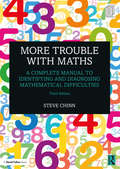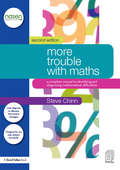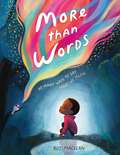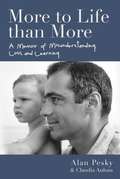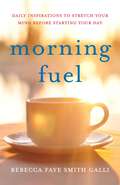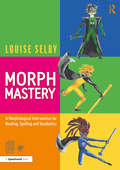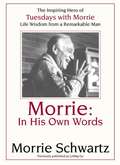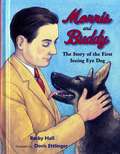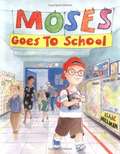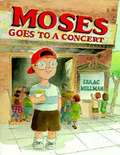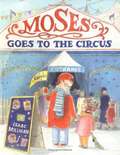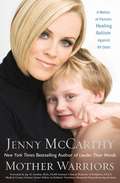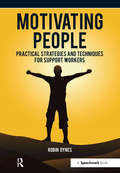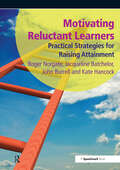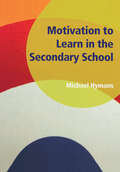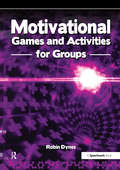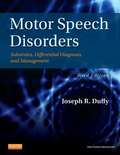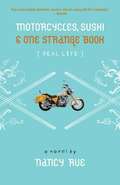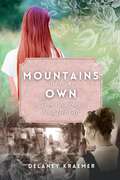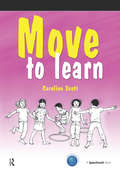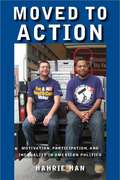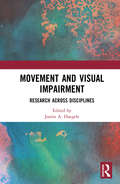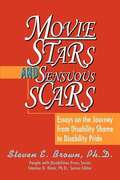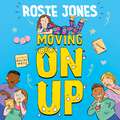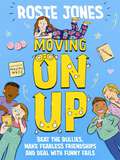- Table View
- List View
More Trouble with Maths: A Complete Manual to Identifying and Diagnosing Mathematical Difficulties (David Fulton / Nasen Ser.)
by Steve ChinnNow in an updated third edition, this invaluable resource takes a practical and accessible approach to identifying and diagnosing many of the factors that contribute to mathematical learning difficulties and dyscalculia. Using a combination of formative and summative approaches, it provides a range of norm-referenced, standardised tests and diagnostic activities, each designed to reveal common error patterns and misconceptions in order to form a basis for intervention. Revised to reflect developments in the understanding of learning difficulties in mathematics, the book gives a diagnostic overview of a range of challenges to mathematical learning, including difficulties in grasping and retaining facts, problems with mathematics vocabulary and maths anxiety. Key features of this book include: Photocopiable tests and activities designed to be presented in a low-stress way Guidance on the interpretation of data, allowing diagnosis and assessment to become integrated into everyday teaching Sample reports, showing the diagnostic tests in practice Drawing on tried and tested methods, as well as the author’s extensive experience and expertise, this book is written in an engaging and user-friendly style. It is a vital resource for anyone who wants to accurately identify the depth and nature of mathematical learning difficulties and dyscalculia.
More Trouble with Maths: A Complete Manual to Identifying and Diagnosing Mathematical Difficulties (nasen spotlight)
by Steve ChinnMore Trouble with Maths acknowledges that there are many reasons why children and adults are unable to function mathematically. Difficulties include problems with rote learning basic facts and procedures, debilitating anxiety, poor working and short-term memories and mathematics vocabulary. Central to this new edition is a range of standardised tests and diagnostic activities, including a 15 minute test of basic mathematics, a thinking style test, tests of basic fact retrieval and maths anxiety. Guiding the reader in the interpretation of tests, this new edition shows how identifying the barriers to learning is the first step in a programme of intervention. Written in an engaging and user-friendly style, Steve Chinn draws on his extensive experience and expertise to: show how to consider and appraise the many factors relating to mathematical learning difficulties explain how these factors can be investigated explore their impact on learning mathematics. Emphasising the need for a clinical approach when assessing individuals, this book shows how diagnosis and assessment can become integrated into everyday teaching. This highly practical and relevant resource is a crucial resource for anyone who wants to accurately and effectively identify the depth and nature of mathematical learning difficulties and dyscalculia.
More than Words: So Many Ways to Say What We Mean
by Roz MacLeanIn the tradition of All Are Welcome and The Day You Begin comes a touching picture book about the many unique ways we communicate, and how we can better listen to and respect these different modes of expression. Nathan doesn't say much. He sure has a lot on his mind, though.At school, Nathan quietly observes the ways his peers communicate. Even when they’re not talking, they’re expressing themselves in all sorts of ways! By witnessing the beauty of communication diversity, Nathan learns and shows his classmates the essential lesson: Not only does everyone have something to say, but seeking to understand one another can be the greatest bridge to friendship and belonging.This tender, stunningly illustrated picture book explores and celebrates the many forms of expression—signing, speaking, singing, smiling, among others— and culminates in a poignant story about connection and understanding.
More to Life than More: A Memoir of Misunderstanding, Loss, and Learning
by Alan Pesky Claudia AulumAt the age of thirty, just as everything was falling into place for him, Lee Pesky died of brain cancer. For his father, Alan, grief came with the realization that he had lost the chance to love Lee as he was—not as he wanted him to be. Ambitious, successful, and always striving for more, Alan had a hard time relating to a son who struggled with learning disabilities at a time when there was little understanding or help for kids who had them. Their relationship was complicated, and now, Lee was gone.More to Life than More is a memoir of misunderstanding, loss, and learning. After Lee&’s death, Alan&’s conception of more crumbles. He launches himself into keeping Lee&’s memory alive by helping kids in a way he wasn&’t able to help his son. It was too late to change his relationship with Lee, but he could create something positive and enduring from his loss: Lee Pesky Learning Center, a non-profit in Idaho dedicated to understanding and helping those with learning differences.In 25 years, LPLC has benefited more than 100,000 children and has become a national force for early childhood literacy. And for Alan, it has meant getting to know the son he had misunderstood and lost.
Morning Fuel: Daily Inspirations to Stretch Your Mind Before Starting Your Day
by Rebecca Faye Smith GalliBest-selling author Rebecca Galli has experienced some of life&’s most difficult challenges: sibling loss, special needs children, paralysis. In this book of daily readings, she offers reflective questions and inspiration for readers to &“fuel up&” on positivity each morning.If there&’s one thing Rebecca Galli knows, it&’s the importance of staying fueled—daily. She&’s had a lot to power through: Her seventeen-year-old brother&’s death. Two children with special needs that include autism and epilepsy. Divorce. And her own paralysis. Galli has lived a life filled with unexpected loss—and learning. Infused with wisdom from Galli&’s deep-thinking pastor father, her ever-optimistic, hostess-with-the-mostest mother, and other memorable family members and friends, Morning Fuel offers stories designed to inspire, encourage, or make you think. Sprinkled throughout are quotes from some of the greatest thinkers of our time—words that have bolstered Galli&’s resolve to power through her darkest valleys. Each entry ends with questions that invite personal application and provoke further pondering. How you start your morning sets the tone for your whole day. Let the wisdom of Morning Fuel help you make that tone a positive one.
Morph Mastery: A Morphological Intervention for Reading, Spelling and Vocabulary
by Louise SelbyMorph Mastery is an accessible, practical guide designed to support learners with specific learning difficulties (SpLD) who are struggling with spelling, reading and vocabulary. It is an effective, research-based and fun solution for when phonics-based teaching has run its course. Understanding the morphological regularities in English helps to support both spelling and reading comprehension, yet there are few practical interventions that take a morphological approach. Morph Mastery combines this exciting new approach with tried-and-tested teaching methods that work. The activities in this book follow three engaging ninja-like characters, Prefa, Root and Sufa, who represent the three core components of morphology (prefixes, root words and suffixes) and use their sceptres to craft words. Key features include: • Exciting and engaging activities and games, designed to be used by individuals or small groups • Detailed, curriculum-linked assessments, enabling specific target setting • Photocopiable and downloadable activity sheets and resources Written in a user-friendly tone, for teaching assistants, teachers and other professionals with little or no specialist knowledge, this book is a must for any school with struggling readers and writers aged 9–13.
Morrie: In His Own Words
by Morrie SchwartzFrom the book: In these remarkable pages are the profound, life-affirming words of Morrie Schwartz (the hero of Tuesdays with Morrie) as he faced his own imminent death. In 1994, at the age of seventy-seven, Schwartz learned he had A L S, commonly known as Lou Gehrig's disease. Undaunted, the former professor embraced his illness, choosing to live passionately and calmly until the end. He also embarked on his greatest teaching adventure: sharing his evolving knowledge of living while dying. With warmth, wisdom, and humor, Morrie reveals how to...live fully in the moment...tap into the powers of the mind to transcend physical limitations...grieve for your losses...reach out to family and friends... develop an inner space for meditation and spiritual connection. It's never too late to become the kind of person you'd like to be. Morrie shows the way in his magnificent legacy of love, forgiveness, transcendence, and redemption, a guide to living fully to the end of your days.
Morris and Buddy: The Story of the First Seeing Eye Dog
by Becky Hall Doris EttlingerMorris Frank lost his sight in 1924, when he was only sixteen. But it wasn't just his sight that he lost--he lost his independence, too. Morris didn't want to be led around by a paid helper or find work making brooms, as was expected of blind people then. He wanted to lead a normal life.One day in 1928, Morris's dad read him an article about Dorothy Harrison Eustis, an American dog trainer living in Switzerland. She had been training dogs for police and army work, but had recently visited a German school where dogs were taught to help soldiers who had been blinded in World War I. Thrilled with this new possibility, Morris set off on his own to Switzerland to meet with Dorothy Eustis and her head trainer, Jack Humphrey. Morris had big ambitions-not only did he want to learn how to work with a guide dog, but he also wanted to start his own guide dog school in America! Morris began training with his dog, Buddy. While he struggled-stepping on Buddy's paws, not paying attention to her cues, and even walking into a gatepost-Buddy waited patiently at his side, allowing him to learn. At last Morris felt ready to return to America with Buddy at his side. But his biggest adventure still lay ahead-founding The Seeing Eye, an organization that has trained thousands of dogs to help other blind people lead independent lives.
Moses Goes to School
by Isaac Millman<P> Moses goes to a special school, a public school for the deaf. All his classmates are deaf or hard of hearing, but that doesn't mean they don't have a lot to say to each other! They communicate in American Sign Language, using visual signs and facial expressions. This is called signing. Isaac Millman follows Moses through a school day, telling the story in pictures and written English, and in American Sign Language (ASL), introducing hearing children to the signs for some of the key words and ideas, including a favorite song in sign language. You can sign along! Picture descriptions describe each sign and its movements.
Moses Goes to a Concert
by Isaac Millman"Moses and his school friends are deaf, but like most children, they have a lot to say. They communicate in American Sign Language, using visual signs and facial expressions. This is called signing. And even though they can't hear, they can enjoy many activities through their other senses. Today, Moses and his classmates are going to a concert. Their teacher, Mr. Samuels, has two surprises in store for them, to make this particular concert a special event."
Moses Goes to the Circus
by Isaac MillmanExperience the Big Apple's Circus of the Senses Moses and his family are going to the circus. Not just any circus but the Big Apple's Circus of the Senses! In a single ring, there are acts by trapeze artists, acrobats, elephants, horses, and clowns - all specially designed for the deaf and hard-of-hearing and the blind. Moses's little sister, Renee, isn't deaf but is learning sign language, and Moses loves teaching her the signs for their day at the circus.
Mother Warriors: A Nation of Parents Healing Autism Against All Odds
by Jenny MccarthyMother Warriors shares the heartfelt and deeply personal stories of families navigating through the many autism therapies to heal their children, as well as Jenny's own journey as an autism advocate and a mother.
Motivating People: Practical Strategies and Techniques for Support Workers
by Robin DynesIn all types of support services and care situations one of the biggest challenges is motivating people to change their behaviour. It particularly applies to individuals who are difficult to motivate because they might lack insight, wilfully ignore or refuse to face their situation, are affected by depression or health problems or are victims of unfortunate circumstances or fear of failure. The task may be to motivate someone to improve their quality of life by participating in a group in a residential home, change a lifestyle because of health reasons, address offending behaviour, learn a new skill to obtain a job or complete an anxiety management programme. The strategies and techniques will help: arouse their interest in making changes; encourage the consideration of change; support their planning for change; mentor the person through planned actions; ensure momentum is maintained; guide the person in making positive use of any relapses; and make sure the change is successfully achieved. This is an invaluable resource for support workers, social workers, health workers, youth workers, probation officers, employment services, tutors and carers. The techniques can be applied when working with individuals or groups in all types of settings including residential homes, day centres, probation, education or youth work.
Motivating Reluctant Learners: Practical Strategies for Raising Attainment
by Roger NorgateThe materials in this book are the product of work undertaken by Hampshire Psychology Service in collaboration with 22 primary and secondary schools to address the needs of children whose academic motivation was proving particularly problematic. The five year project involved feedback and review sessions which helped refine the programme. There are four sections: Information on attribution theory and its application in the classroom; Practical issues on implementing the programme; Support for staff including a PowerPoint training session; The 12 session pupil programme including facilitator notes. The programme is designed to give pupils experience of success at the same time as encouraging them to attribute the success to their own effort, skills and strategies. It helps them to understand: ability is not fixed; learning is difficult for everyone and requires effort; the significance of using strategies including help-seeking and self-talk; the important of taking responsibility and setting SMART goals. Participating staff reported changes in pupils: the course effected a significant change and they moved into Year 10 options far more positive and motivated. And also in themselves: I thought the theory was one of the best things ...it was as if a light bulb had been turned on. I have really gained in confidence as a consequence. This pack contains a CD ROM with copiable activities, DVD clips of pupil intervies and using the programme, an example of a pupil booklet and the PowerPoint presentation.
Motivation to Learn in the Secondary School
by Michael HymansTeachers have an enormous impact on how their students approach learning situations. Motivation to Learn in the Secondary School provides the opportunity for senior management teams to enhance learning and teaching by looking at theories of motivation and then relating these to the realities of the classroom. The book looks at the role of senior leaders and how they can encourage their staff to: explore the role that student-teacher relationships play in encouraging student motivation; highlight the importance of emotional literacy for motivating teaching and learning; explore a range of ideas to nurture motivation for the promotion of effective teaching and learning, such as accelerated learning, learning styles, multiple intelligences, meta-cognition and thinking skills. Each chapter shows how the concepts and theories convert into practice. These are identified throughout the book as TiPs (Theory into Practice) to: aid understanding of the model; encourage student motivation through particular practices. There are 38 TiPs, which include activities with handouts and information pages. These are designed for individual and/or groups of staff to use for reflection and development of action plans to promote student motivation to learn.
Motivational Games and Activities for Groups: Exercises to Energise, Enthuse and Inspire
by Robin DynesHow can you encourage people to be motivated? How can you create that sense of yearning to achieve or reach a goal? How can you energise and inspire group members? The exercises and activities in this resource will help you to motivate your team or the group with which you are working. The activities are organised in sections from which you can choose to meet particular group needs. These include: Ice breakers and warm ups; Trust building; Building self-esteem; Inspiring creativity; Aligning values; Creating an inspiring environment; Becoming solution focused; Perception; Resilience; Team building; Visualising and setting goals; Energy boosters; Overcoming anxiety and fear; Managing stress; Stopping procrastination; and; Using competition. Whether your group is small or large you will find something for any setting. Many of the activities can also be used on a one-to-one basis in supervision, with clients or students. The activities are interactive and fun. Trainers, youth leaders, counsellors, group leaders, team managers, teachers, care workers and probation officers will find the resource one in which they constantly dip for inspiration. Robin Dynes is the Social Inclusion Officer for Skills & Learning in his local authority. His main role has been to develop an innovative outreach curriculum that is accessible and meets the needs of people with disabilities, older people and others who are vulnerable. The aim is to ensure that people with disabilities have equal opportunity and an active and fulfilling role within the community.
Motor Speech Disorders: Substrates, Differential Diagnosis, and Management (Third Edition)
by Joseph R. DuffyWith expanded and updated information including current techniques, approaches, and case studies, the 3rd edition of this bestselling book continues its reputation as a dependable and outstanding evidence-based source on acquired motor speech disorders in adults. It covers the substrates of motor speech and its disorders, the disorders and their diagnoses, and management -- focusing on integrating what is known about the bases of motor speech disorders with the realities of clinical practice to ensure readers have the key content they need to be effective practitioners.<p><p> <b>Key Features</b><p> Three-part organization first covers the neurologic underpinnings of speech, then the various disorders resulting from problems in the nervous system, and then the basic principles and disorder-specific management strategies.<p> Emphasis on evidence-based practice helps distill disparate information and stresses the best practices within motor speech disorders.<p> Cutting-edge research ensures this book contains the most comprehensive and up-to-date look at the state of motor speech disorders.<p> Case studies help clarify dense and difficult content and help hone your critical thinking skills. Summary tables and boxes offer easy access to important information such as causes and characteristics to aid in differential diagnosis.<p> Chapter outline and summary sections keep you focused on the most significant information.
Motorcycles, Sushi and One Strange Book (Real Life #1)
by Nancy RueFifteen-year-old Jessie Hatcher has ADHD and can usually use her bubbly charm to cover up her problems. But when her biological father appears from nowhere and tells her she'll be spending time with him in Florida, Jessie finds she'll need more than charm this time. In fact, a mysterious book might be the answer to her problems
Mountains of Our Own: A Teen’s Journey to Find Her Gift
by Delaney KraemerFifteen-year-old Faith has epilepsy. She has never questioned her ability to fit in with her friends…until now. They all seem to have special gifts. Did the Lord somehow overlook her? <P><P> Faith has dealt with epilepsy for a decade, and her friends have always been by her side. Her sense of fitting in, her talents, her purpose, and her relationships are fundamentals that Faith has never questioned. When she and her friends participate in the school play, unexpected events cause her to doubt herself. Will she find the courage to put her trust in Jesus and His plan?
Move to Learn
by Caroline ScottMasses of activities based on the premise that movement, particularly if it is specific and intentional, enhances learning. "Move to Learn" is a movement programme for children aged five to eight years, delivered in sessions, working one-to-one with an adult or as a small group. Use the programme to liven up a day, provide a 'brain break' in the curriculum or as a complete change for a pupil who is having an emotionally challenging day. Moving promotes learning and other outcomes will follow: Emotional - encouraging happy, secure, confident, motivated and positive emotional states in the limbic system of the brain to support a sense of well-being; Cognitive - using movement to create and strengthen neural pathways, to integrate brain activity and develop 'whole brain' learning; Motor - enabling children to develop their gross and fine motor skills, and to understand being active or calm and to know the difference; Social - using activities to have fun and play together, and to interact and build good relationships; and, Language - to encourage good listening skills and attending to instructions, and to learn to use self-talk to mediate learning. The activities are arranged in ten sections to address different types of movement: Stamina; Large motor actions; Mobility; Balance; Body awareness; Spatial awareness; Dexterity; Fine motor skills; Rhythm and sequence; and, Relaxation. This title includes six sample lesson plans and forms for children's evaluation, parents' evaluation, teachers' questionnaire and parents' questionnaire.
Moved to Action
by Hahrie C. HanHan (political science, Wellesley College and health policy, Harvard U. ) investigates how people without many educational, financial, and civic resources become engaged to participate in politics. Many studies show the most people who participate in politics are interested in it, have the resources, and are asked; she looks at people who have none of that, but dive in anyway. She covers the challenge of political equality, theoretical foundations, issue publics and the distribution of political motivation, an empirical look at issue publics and participation, pathways to participation, and looking ahead. Her case studies come from a wide range of issues, organizations, and campaigns. Annotation c2010 Book News, Inc. , Portland, OR (booknews. com)
Movement and Visual Impairment: Research across Disciplines
by Justin A. HaegeleThis is the first book to offer an in-depth review of research pertaining to individuals with visual impairments across the full span of movement-related disciplines, from biomechanics and motor learning to physical education and Paralympic sport. Each chapter highlights current research trends, future research directions, and practical implications in a key discipline or area of professional practice, drawing on empirical research evidence and opening up new avenues for cross-disciplinary working. Covering physical activity across the life course, from children and young people through to older adults, and addressing the important topic of deafblindness in some depth, the book goes further than any other book published to date on visual impairment and movement. This is essential reading for all advanced students and researchers working in sport, exercise and disability, and an invaluable reference for practitioners and service providers, from in-service teachers and camp directors to physical therapists and physical activity promotion specialists.
Movie Stars and Sensuous Scars: Essays on the Journey from Disability Shame to Disability Pride
by Steven BrownThis 2003 essay compilation focuses on a journey, my own and that of others, from feeling shame about our disabilities to recognizing who we are with pride. This is not a journey without bumps, bruises--and scars--along the way. The discussion continues to this day, on social media, in books, essays and articles and poetry. Much of what is in this book paved the way for these current discussions.
Moving On Up: Beat the bullies, make fearless friendships and deal with funny fails
by Rosie JonesA funny and reassuring guide for children facing big changes. Whether you're starting a new school, finding it difficult to make friends, dealing with bullies, or experiencing your first crush, this book has all the advice you need to get through it. Comedian Rosie Jones has gone through her school diaries and shares her anecdotes and advice to help you navigate big changes and feel confident.No one knows quite as much about friendship fails, facing bullies and being TOTALLY embarrassed, then comedian Rosie Jones. You name a COMPLETELY AWKWARD situation, and she's been there, got the t-shirt and probably done it all again! Rosie knows just how much it SUCKS to grow up, but also how much fun starting a new school and meeting new people can be. So sit back, grab a packet of crisps and crunch your way through this super handy guide to making friends, beating the bullies and dealing with those tricky 'big things'.An inclusive guide to building confidence and adapting to life changes.
Moving On Up: Beat the bullies, make fearless friendships and deal with funny fails
by Rosie JonesNavigate the perils of growing up in this hilarious and confidence-building guide to friendship, beating the bullies and overcoming cringe-worthy moments - by comedian and bestselling children's writer, Rosie Jones.No one knows quite as much about friendship fails, dealing with bullies and being TOTALLY embarrassed, then Rosie Jones. You name a completely awkward situation, and she's been there, got the t-shirt and probably done it all again. Rosie knows just how hard growing up can be, but she also knows that you can overcome the difficult and embarrassing moments with the help of good friends and a good sense of humour. So, sit back, grab a packet of crisps and crunch your way through this super handy guide to navigating all the tricky growing up stuff (and styling out of all the totally cringe moments life throws your way).Perfect for fans of the Edie Eckhart series!
